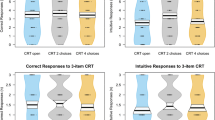Abstract
In a number of psychological studies, answers to reasoning vignettes have been shown to result from both intuitive and deliberate response processes. This paper utilizes a psychometric model to separate these two response tendencies. An experimental application shows that the proposed model facilitates the analysis of dual-process item responses and the assessment of individual-difference factors, as well as conditions that favor one response tendency over another one.



Similar content being viewed by others
References
Alter, A., Oppenheimer, D., Epley, N., & Eyre, R. (2007). Overcoming intuition: Metacognitive difficulty activates analytic reasoning. Journal of Experimental Psychology: General, 136, 569–576.
Bock, R.D. (1972). Estimating item parameters and latent ability when responses are scored in two or more nominal categories. Psychometrika, 37, 29–51.
Bock, R.D., & Aitkin, M. (1981). Marginal maximum likelihood estimation of item parameters: Application of an EM algorithm. Psychometrika, 46, 443–459.
Bodenhausen, G.V. (1990). Stereotypes as judgmental heuristics: Evidence of circadian variations in discrimination. Psychological Science, 1, 319–322.
De Boeck, P., & Wilson, M. (2004). Explanatory item response models. New York: Springer.
De Neys, W. (2006). Dual processing in reasoning. Psychological Science, 17, 428–433.
Evans, J.S.B.T. (2008). Dual-processing accounts of reasoning, judgment and social cognition. Annual Review of Psychology, 59, 255–278.
Frederick, S. (2005). Cognitive reflection and decision making. Journal of Economic Perspectives, 19, 25–42.
Gill, P., Murray, W., & Wright, M. (1981). Practical optimization. London: Academic Press.
Horne, J., & Ostberg, O. (1976). A self-assessment questionnaire to determine morningness–eveningness in human circadian rhythms. International Journal of Chronobiology, 4, 97–110.
Kahneman, D., & Frederick, S. (2002). Representativeness revisited: Attribute substitution in intuitive judgment. In T. Gilovich, D. Griffin, & D. Kahneman (Eds.), Heuristics and biases: The psychology of intuitive judgments (pp. 49–81). Cambridge: Cambridge University Press.
Kahneman, D., & Frederick, S. (2005). A model of heuristic judgment. In K.J. Holyoak & R.G. Morrison (Eds.), The Cambridge handbook of thinking and reasoning (pp. 267–293). Cambridge: Cambridge University Press.
Logan, G.D., Schachar, R.J., & Tannock, R. (1997). Impulsivity and inhibitory control. Psychological Science, 8, 60–64.
Orlando, M., & Thissen, D. (2000). New item fit indices for dichotomous item response theory models. Applied Psychological Measurement, 24, 50–64.
Rasch, G. (1960). Probabilistic models for some intelligence and attainment tests. Copenhagen: Danish Institute for Educational Research.
Stanovich, K.E. (2009). What intelligence tests miss: The psychology of rational thought. New Haven: Yale University Press.
Stanovich, K.E., & West, R.F. (2008). On the relative independence of thinking biases and cognitive ability. Journal of Personality and Social Psychology, 94, 672–695.
Sternberg, R. (2000). Handbook of intelligence. Cambridge: Cambridge University Press.
Strack, F., Martin, L.L., & Schwarz, N. (1988). Priming and communication: The social determinants of information use in judgments of life satisfaction. European Journal of Social Psychology, 8, 429–442.
Suh, Y., & Bolt, D.M. (2010). Nested logit models for multiple-choice item response data. Psychometrika, 75, 454–473.
Thissen, D., & Steinberg, L. (1984). A response model for multiple choice items. Psychometrika, 49, 501–519.
Thurstone, L.L. (1927). The nature of intelligence. New York: Harcourt.
Tutz, F. (1997). Sequential models for ordered responses. In W.J. van der Linden & R.K. Hambleton (Eds.), Handbook of modern item response theory (pp. 139–152). New York: Springer.
Verhelst, N.D., Glass, C.A.W., & de Vries, H.H. (1997). A steps model to analyze partial credit. In W.J. van der Linden & R.K. Hambleton (Eds.), Handbook of modern item response theory (pp. 123–138). New York: Springer.
Author information
Authors and Affiliations
Corresponding author
Rights and permissions
About this article
Cite this article
Böckenholt, U. The Cognitive-Miser Response Model: Testing for Intuitive and Deliberate Reasoning. Psychometrika 77, 388–399 (2012). https://doi.org/10.1007/s11336-012-9251-y
Received:
Revised:
Published:
Issue Date:
DOI: https://doi.org/10.1007/s11336-012-9251-y




